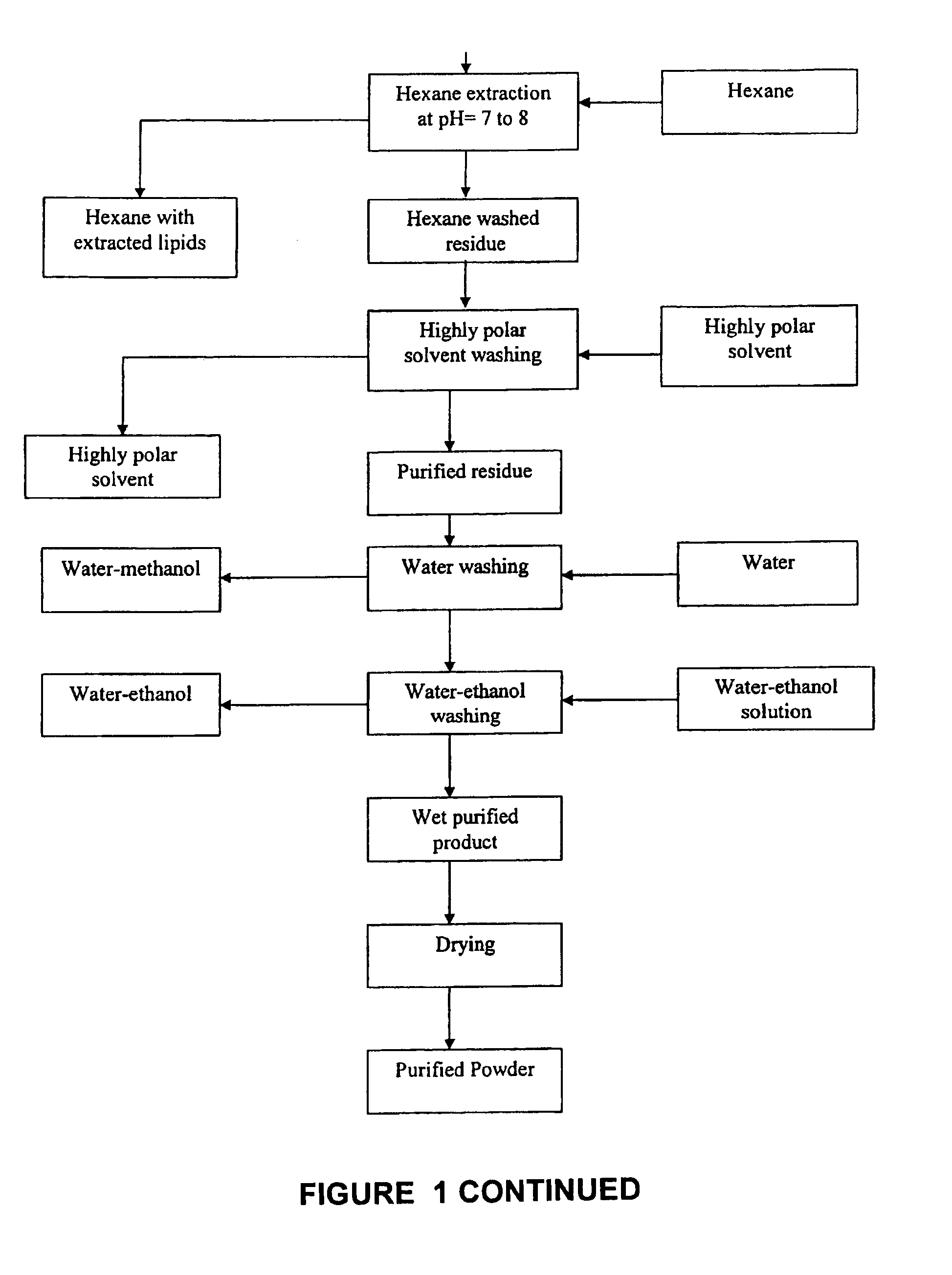Process for purification of free xanthophylls
a technology of xanthophyll and free xanthophyll, which is applied in the field of purification of free xanthophyll, can solve the problems of poor solubility of xanthophyll esters, halogenated solvents are banned for human food applications, and use of halogenated solvents, so as to achieve the effect of increasing the polarity of the solven
- Summary
- Abstract
- Description
- Claims
- Application Information
AI Technical Summary
Benefits of technology
Problems solved by technology
Method used
Image
Examples
example 1
[0055]In a two liter reaction vessel 250 gm of marigold extract were saponified with a 50% aqueous solution of potassium hydroxide at a temperature of 103° C. The starting material contained 110.3 gm / kg of total carotenoids. The saponified material was then mixed with 1420 ml of a 9.8% sodium chloride solution in water and stirred for 20 minutes at 85° C. It was then allowed to rest for 30 minutes at 85° C. and after a two phase separation appeared, the bottom saline phase was removed with a vacuum suction. The remaining oleoresin was treated two more times with 1000 ml of a 7% sodium chloride solution as described above. The saline washed oleoresin was then transferred to a 4 L vessel and mixed vigorously with 3000 ml of hexane at 35° C. during 10 minutes. It was then allowed to rest for two and a half hours and the upper phase was decanted along with an interface containing hydrated gums. A second hexane treatment was performed in the same manner but with 1500 ml of solvent. The r...
example 2
[0056]Saponification of 100 gm of marigold extract was carried out using 36 gm of a 50% sodium hydroxide aqueous solution at a temperature of 103° C. The extract had 105 gm / kg of total carotenoids before reacting. The saponified product was stirred for 10 minutes in 500 ml of a 12% potassium chloride solution at 90° C. and rested at the same temperature for an hour. A bottom heavier phase was separated from an upper pigmented phase and this washing was repeated using the same conditions. The washed oleoresin was then mixed with 2 liters of hexane at 30° C. during 15 minutes. Mixing was then stopped and an upper hexane layer that was formed was decanted after allowing to rest for 5 hours. A thin layer of suspended solids was eliminated along with the hexane phase. A second hexane treatment was repeated with the same volume and under the same conditions and the hexane layer decanted. Excess hexane was evaporated by stirring at 55° C. and under vacuum (600 mm Hg.). The hexane washed pa...
example 3
[0057]A batch of 300 gm of boxthorn berries (Lycium chinensis) with 0.89 gm / kg of total carotenoids were soaked in 1200 ml of a 1:1 methanol:water solution for 12 hours. The berries were then homogenized in an electric blender and the total mass passed through a polyester fiber filter. The material retained in the filter was extracted with hexane at 40° C. and filtered using Whatman No. 2 filter paper. The extractions were repeated until the extract was practically colorless. This process used 5400 ml of hexane. The hexane extracts were pooled and the volume reduced to 2000 ml by evaporation under vacuum. The partially concentrated hexane extracts were then washed with 2000 ml of water to eliminate gums and other water soluble solids using separatory funnels. The water washed hexane extract was then passed through a bed of anhydrous sodium sulfate to eliminate moisture followed by solvent evaporation under vacuum to obtain a concentrated pigment extract which weighed 3 gm. The conce...
PUM
| Property | Measurement | Unit |
|---|---|---|
| temperatures | aaaaa | aaaaa |
| temperature | aaaaa | aaaaa |
| temperature | aaaaa | aaaaa |
Abstract
Description
Claims
Application Information
 Login to View More
Login to View More - R&D
- Intellectual Property
- Life Sciences
- Materials
- Tech Scout
- Unparalleled Data Quality
- Higher Quality Content
- 60% Fewer Hallucinations
Browse by: Latest US Patents, China's latest patents, Technical Efficacy Thesaurus, Application Domain, Technology Topic, Popular Technical Reports.
© 2025 PatSnap. All rights reserved.Legal|Privacy policy|Modern Slavery Act Transparency Statement|Sitemap|About US| Contact US: help@patsnap.com


